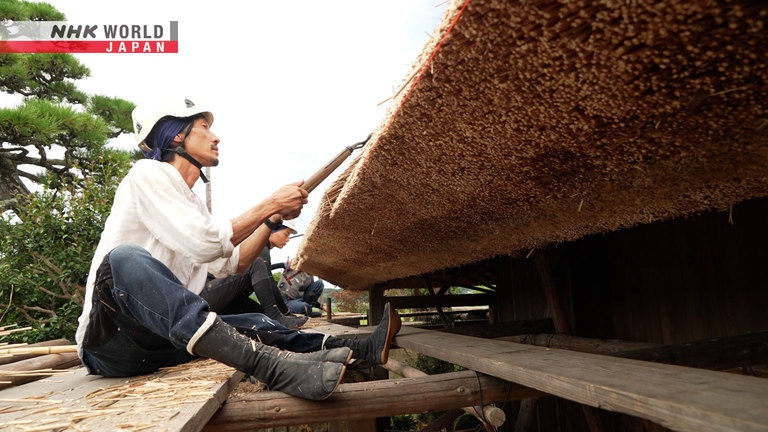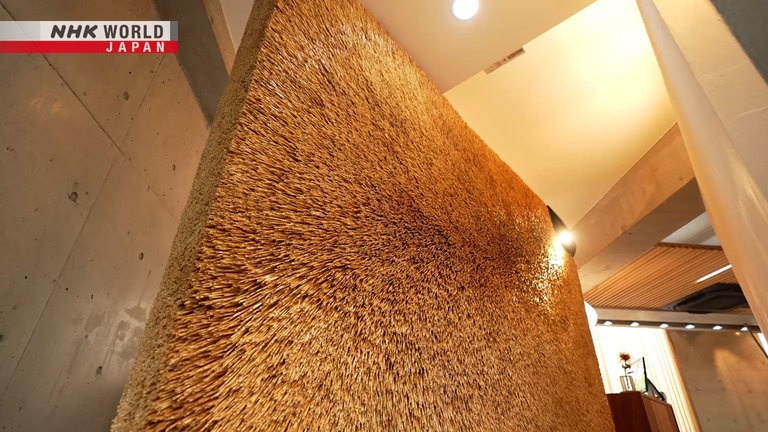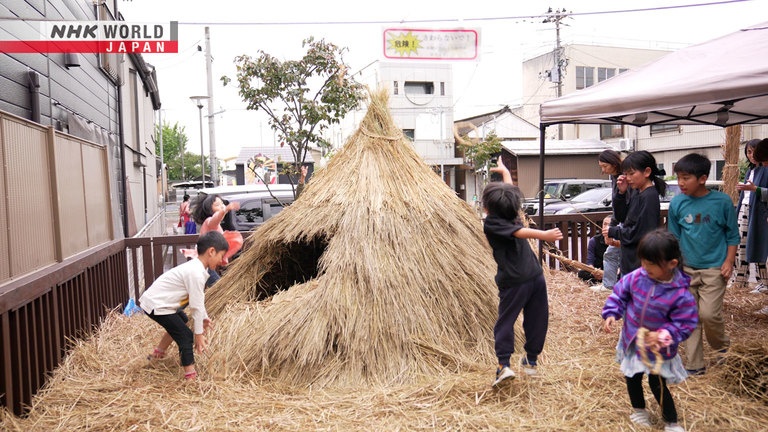Thatching Innovator - Sagara Ikuya
The thatched roofs found on traditional Japanese houses are declining in number. They're hard to maintain, and passing on the relevant skills is difficult. However, Sagara Ikuya is giving this ancient craft an innovative twist. He also works hard to develop the skills of young people. Thatched roofs represent the wisdom of our ancestors, who struggled to coexist with nature, and we discover how Sagara is using that tradition to explore new possibilities.




Transcript
FRONTRUNNERS
Thatched roofs are a dying art.
It's a field packed with so much skill and knowhow.
Like a different house! Gorgeous!
I want to raise awareness.
Progress is tough, but it's important.
Thatching made me who I am, so I want to give something back.
Thatching innovator
Sagara Ikuya
The village of Ogocho,
is located in Kita Ward, northern Kobe, Hyogo Prefecture.
This hilly region boasts around 700 traditional thatched homes.
Providing a glimpse into the landscape of a bygone Japan.
It's also home to one of the country's
few remaining professional thatchers, Sagara Ikuya.
Let's do this.
We join him on his latest assignment.
This traditional home is around 180 years old.
And it's almost a century since the roof was last rethatched.
Typical materials for Japanese thatching
include locally sourced pampas grass, reeds, and rice straw.
And this time-honored construction technique
provides both insulation and ventilation.
These look good.
Today, Sagara's team are laying the base layer of dried sedge.
All of the materials, from straw, to rope, to bamboo,
are natural and biodegradable,
and castoffs can even be repurposed as fertilizer.
Once the bundles have been laid and evened out,
they are fixed in place with rope and bamboo.
It's a traditional approach dating back thousands of years.
But not all bundles are the same,
with differences in length and thickness.
It takes years of experience to quickly discern
the qualities of each one and lay them out evenly.
Not every bundle spreads out nicely just like that.
The art of getting all these random sprigs laid out evenly
is the basis of traditional thatching.
The aim is to combine all these elements into a single roof.
It's hard to tell,
but when you're sorting each bundle,
your fingers are quite active around the back too, like so.
Though you can't see that from the front.
Around the back, like so.
It's painstaking, meticulous work.
And leaving even the slightest gaps
can severely impair the longevity of the roof.
This home is owned by Morii Hisako.
Now aged 93, she's been living here since she was 20.
Everyone used to have thatched roofs.
Most build modern houses nowadays.
But it's great how cool thatched buildings are.
I never use air conditioning in summer.
But in all those years,
this is the first time Morii has been through a full re-thatching.
It's the first time.
And it's such a big job.
I wonder how it'll look when it's finished.
Since the loss of her husband five years ago,
she has lived here alone,
tending the surrounding fields herself.
Daughter Kazuko, who comes to check in on her several times a week,
had been concerned for some time by the state of the house.
The thatch had thinned out, and was letting the rain in.
What's good about thatched homes is
how they're cool in summer and warm in winter.
It's a traditional approach using earth and reeds.
I like how the homes in Ogocho are at one with nature.
Having learned about subsidies
provided by Kobe City to preserve this region's traditional landscape,
they decided to have the home rethatched.
I wonder if I'll live to see it finished.
You'll probably outlast me!
Who can say?
Once the bundles are laid,
the next step is to beat them out evenly using a special tool.
This helps create the shape of the roof.
If we don't get this right, it could end up too curved or bowed.
It's tough even with years of experience.
It may look straightforward,
but natural materials present all sorts of challenges.
The reeds grow naturally, so they're not all straight.
And you can't always tell by looking.
You get a feel as you beat them out.
That feedback at each stage helps you figure things out.
It's this kind of knowhow
that has been passed down through the centuries.
A job like this one typically takes around two months.
Over thousands of years,
my predecessors have worked out the most efficient ways
to get the best results.
It's a field packed with so much skill and knowhow,
honed through the ages.
Born and raised in Ogocho, after high school,
Sagara Ikuya went to technical college to study architecture.
But after graduation, he spent the next four years cloistered at home,
unsure about what to do next.
It's quite hard to admit this,
but I couldn't take just going to the same place
and sitting in a chair all day.
That's not the life for me, so I didn't even search for a graduate job.
In my late teens and early 20s, I wasn't really thinking about the future.
And while pondering the right path,
Sagara remembered a key experience from his early teens.
The Great Hanshin-Awaji Earthquake of 1995.
All the infrastructure shut down, power, water, gas.
I always took it for granted that water and power would always be there
at the turn of a faucet or the flip of a switch.
But I realized that wasn't the case.
I decided I wanted to learn a practical skill
that I'd be able to make a living from.
By pure chance,
he happened across an ad for a part-time job with a thatcher.
You'd cut the reeds, lay a roof, and then return the leftovers to nature.
And when I learned that wasn't just about disposing of waste
but creating fertilizer for the future,
I thought this is the job for me.
Ogocho has a lot of thatched buildings
and I guess I'd always just taken them for granted.
I wondered why I'd never paid them any heed before.
It left a big impact.
Having fallen in love with thatching,
Sagara spent five years as an apprentice before going solo
and later setting up his own company.
And across his career to date,
he's worked on over 100 properties,
traveling the length and breadth of Japan.
I've met a lot of seniors who live in thatched homes.
But during Japan's economic boom in the late 20th century,
they took on a negative image, one of poverty.
People apologize to me for making me work on their "grubby homes,"
but that's not how I see them at all.
And it really bothers me how people nowadays
just can't seem to understand their appeal.
Right from the start,
I've felt this craft had been refined over thousands of years,
so I couldn't let it end with me.
Two months into the restoration job on Morii Hisako's home,
the new roof is almost complete.
I hope this one's tasty!
Having finished laying the thatch,
Sagara and his team are adding the final touches.
They use sheers to trim the roof into its final shape.
And this step can also make all the difference in terms of water resistance.
You have to make sure that when it rains,
the water can drain away properly.
Creating a sharp edge like this helps the water drain away,
so that's what we focus on as we work.
Working alongside him is fourth-year apprentice, Konishi Kiichi.
And Sagara notices something about the sound of Konishi's shears.
Hey, what's with that dainty sound?
Maybe the length of the handles?
Woah, stubby! So that's it!
But Konishi is struggling to find the right rhythm with his cutting.
Kiichi! Try copying my rhythm.
I'm OK if I take my time,
but when I try to speed up...
It's tough.
But Sagara knows how vital it is
that Konishi learns to judge the line of the roof by eye
and instinctively cut to an aesthetically pleasing, weather resistant shape.
The shears should be an extension of yourself.
It may take years of practice, but it becomes second nature.
I've used these shears ever since I went solo.
If I lost them, it'd be like losing a part of me.
From a once worn-out, leaky roof just a few months ago...
Morii Hisako's home has been restored to its former glory.
A traditional thatch to provide year-round comfort,
and all made with natural materials.
I didn't know how it'd turn out, but I'm so glad we found you.
These homes are a symbol of our region.
So, on a personal level, I'm happy to help preserve that.
Amazing.
I wish I could show your father.
Like a different house! Gorgeous!
It's just incredible.
Sagara too, has made his life here in the town where he was born.
The family unit also includes wife Mika
and their two boys, aged five and one.
Take a good look at his face.
Cicadas come out of the ground.
Out of their nests, then shed their skins.
And fittingly enough, Ikuya and Mika also met through thatching.
As a student, I took part in a project to restore a traditional home.
That's where we met, when he was still an apprentice thatcher.
That's how it was.
And even during quality time with family,
Ikuya's mind is constantly on thatching.
My work's so wrapped up with my everyday life.
I can't help thinking about it.
Even our honeymoon was like a thatching field trip.
- It was research.
- I even wrote a report!
I'd love to go on a leisure trip for once!
Let's do that.
Somewhere with no thatched buildings.
If there are any, he can't help but look.
How about if there's one on the way?
I knew it! You always say that!
But Sagara's life as a thatcher is faced with major uncertainties.
The high cost of re-thatching roofs and fire regulations
that limit their use in new construction
have long seen the art on a steady decline.
From an estimated five million thatched buildings across Japan in the 1960s,
by the 2010s, that figure was down to around just 100,000.
Thatched roofs are a dying art, a distant memory to most.
And I worry that they may disappear altogether.
But people don't see that hardship, don't know about thatched roofs.
So as a first step, I want to raise awareness.
That's my constant goal.
I want to get people interested in thatching
so they'll actively engage with the field.
And that mindset has driven various activities
to promote this time-honored craft.
We join Sagara for one such project at a modern art gallery in Tokyo.
It's for a special performance by pianist and visual artist, Mukaiyama Tomoko,
who reached out to Sagara in the hope of creating
a setting inspired by climate change and the natural world.
Oof. Pretty heavy.
Let's give it a try.
Looks pretty good!
These rice husks are a byproduct of commercial rice production.
The aim is to evoke thatched roofs using a familiar everyday material.
It's an abundant byproduct of farming,
but simply by placing it somewhere unexpected like this,
you create something really fresh and intriguing, even to me.
Sorry, it's just too pretty.
Pretty, huh? Shall I mess it up?
But it is prettier than I expected.
Fantastic. You just want to touch them.
After three days of work, the performance space is complete,
with the bare concrete hall transformed
into a celebration of natural materials.
It's like a fusion of thatching with other modes of expression.
And maybe, it can provide some hints
on how to crack open the world of thatching,
which can be pretty insular.
And in line with these goals,
Sagara's activities have attracted young people from all over Japan
to come and get involved with thatching.
Of his current team of 12, 5 are in their 20s.
Including Fukuyama Natsumi.
For the past two years, she's been working under Sagara
to develop new products using thatching materials.
I'm wondering how much I should cut.
It looks pretty good. Maybe a little lower?
Looks good with green.
Oh, that is cute.
I was actually studying urban planning,
but I realized, I didn't like how such projects impacted nature.
Thatch is a wonderful material.
It has a strong artistic background and a cultural appeal.
And the best place to make things with such materials
was here with Sagara-san.
And with the goal of upholding tradition while creating something new,
Sagara's team has worked on various projects using thatching materials.
Long time no see!
Like the wheat straw wall display at this local hair salon.
Owner Miyazaki Kazuyoshi reached out in person to Sagara
to create something special.
I like how it looks like hair.
That's what I wanted. Something to symbolize hair.
But I'd never seen anything quite like this before.
It's a fresh take on traditional thatching.
With thatched roofs on the decline,
I'd been wanting to explore new possibilities for thatching in interior design,
and I do feel this is a good example of that.
(Tokyo)
For another recent artistic collaboration in Tokyo,
Sagara made creative use of rice straw.
Providing a rare chance
to put residents of the capital in touch with traditional thatching.
Wow!
It really drives home how people in centuries past
had the skills and knowhow to create comfortable living spaces.
There's a warmth you don't find in modern homes.
Something that feels very welcoming.
And Sagara hopes that conveying the appeal of thatching like this
might help to create the conditions for its use in a new wave of construction.
It's restricted by current planning laws,
but I feel that thatching retains a really strong appeal.
Europe's seen a relaxation of rules that has opened it up for use again.
I've seen pictures of rows of thatched homes.
So I want to promote conditions
that open up easier use of thatching here in Japan, too.
Mitsuke, Niigata Prefecture.
Sagara is here for another initiative
that he's been pursuing for over a decade.
Organizing thatching workshops for children.
Wanna tie a rope?
Help me out.
This rope is made of straw.
You thread it through here.
Pull it this way.
- Yay, I did it!
- Well done!
Turn this one round.
This one too?
That's it.
- Wanna do some more?
- Yeah!
The aim is to give kids with fewer opportunities to experience nature,
the chance to learn about thatching, and feel its appeal.
I hope they'll remember this at key moments in their adulthood.
Could be the thatchers of the future.
Could well be.
One kid who joined one of my workshops,
came back to me as a teen apprentice.
That's the kind of thing that can happen.
So what is it that motivates Sagara Ikuya as a "frontrunner" in his field?
Thatching's part of a cycle.
Everything goes back to the soil without harming the environment.
It really combines both the harshness and the plenty of nature.
And I think thatching has a lot to teach us
about potential approaches to sustainability.
If people today would pick up on that,
I think it could solve a lot of social issues.
In all honesty, that's what drives me on.